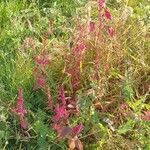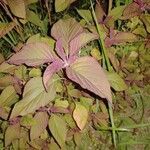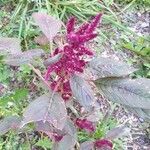Stem green or purple, 10-80 cm tall, branched, glabrous or slightly pilose. Petiole 1-7.5 cm, glabrous; leaf blade rhombic-ovate or oblong-lanceolate, 3-10 × 1.5-3.5 cm, glabrous, base cuneate, margin entire or undulate, apex acute or acuminate. Complex thyrsoid structures terminal, erect, cylindric, ca. 25 cm, 1-2.5 cm in diam., branched or not, composed of many spikes; lateral spikes short, ca. 6 cm. Bracts green or purple, ovate, subulate, 4-5 mm, ca. 2 × as long as perianth, apex distinctly long pointed. Tepals green or purple, with a dark midvein, oblong, ca. as long as or longer than fruit, apex acute or acuminate. Stigmas 2 or 3. Utricles exceeding perianth, green, tinged purple above, rhomboid-ovoid, 3-4 mm, circumscissile. Seeds white, subglobose, ca. 1 mm in diam. Fl. Jul-Aug, fr. Aug-Sep. 2n = 32.
Cult. ornamental and grain amaranth, apparently derived from A. powellii; infl large and showy, stiffly erect, mostly bright red or bright yellow in life, or sometimes bright green; bracts with rather strong midrib, about equaling the style-branches, these spreading from the thickened base; sep all over 2 mm, nearly equaling the fr, all lanceolate, acute; seeds of ornamental forms generally dark brown, of grain forms mostly pale ivory. Amer. cultigen, originally cult. for grain, now much more commonly so in the Old World than in the New; widely cult. as an ornamental, and occasionally escaping or persistent, but scarcely established in our range.
An annual herb. It grows to 1.2 m high and 50 cm across. The leaves are oblong or sword shaped and purple-green. They are 15 cm long. The flowers are more erect than Amaranthus cruentus. They are large and thick. The pointed bracts give a prickly appearance. The flower clusters can be 15 cm long or more. The seed is usually pale.







